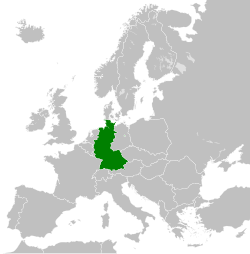West German
| Federal Republic of Germany | ||||||||||||
|
Bundesrepublik Deutschland République fédérale d'Allemagne |
||||||||||||
|
||||||||||||
|
||||||||||||
|
Motto "Einigkeit und Recht und Freiheit" "Unity and Justice and Freedom" |
||||||||||||
Anthem
|
||||||||||||
|
Territory of the Federal Republic of Germany (West Germany) from 1 January 1957 until 3 October 1990
|
||||||||||||
| Capital |
Berlin (de jure) Bonn (de facto) |
|||||||||||
| Languages |
German English French |
|||||||||||
| Government | Federal parliamentary constitutional republic | |||||||||||
| President | ||||||||||||
| • | 1949–1959 | Theodor Heuss | ||||||||||
| • | 1959–1969 | Heinrich Lübke | ||||||||||
| • | 1969–1974 | Gustav Heinemann | ||||||||||
| • | 1974–1979 | Walter Scheel | ||||||||||
| • | 1979–1984 | Karl Carstens | ||||||||||
| • | 1984–1990 | Richard von Weizsäckerb | ||||||||||
| Chancellor | ||||||||||||
| • | 1949–1963 | Konrad Adenauer | ||||||||||
| • | 1963–1966 | Ludwig Erhard | ||||||||||
| • | 1966–1969 | Kurt Georg Kiesinger | ||||||||||
| • | 1969–1974 | Willy Brandt | ||||||||||
| • | 1974–1982 | Helmut Schmidt | ||||||||||
| • | 1982–1990 | Helmut Kohlc | ||||||||||
| Legislature | Bundestag | |||||||||||
| Historical era | Cold War | |||||||||||
| • | Formation | 23 May 1949 | ||||||||||
| • | Accession of Saar Protectorate | 1 January 1957 | ||||||||||
| • | Admitted to the United Nations | 18 September 1973 | ||||||||||
| • | Reunification | 3 October 1990 | ||||||||||
| Area | ||||||||||||
| • | 1990 | 248,577 km² (95,976 sq mi) | ||||||||||
| Population | ||||||||||||
| • | 1950 est. | 50,958,000d | ||||||||||
| • | 1970 est. | 61,001,000 | ||||||||||
| • | 1990 est. | 63,254,000 | ||||||||||
| Density | 254.5 /km² (659.1 /sq mi) | |||||||||||
| Currency | Deutsche Marke (DM) | |||||||||||
| Internet TLD | .de | |||||||||||
| Calling code | +49 | |||||||||||
|
||||||||||||
| Today part of |
|
|||||||||||
| a. | From 1952 to 1991, the official national anthem of Germany was Deutschlandlied in its entirety, but only the third stanza was to be sung in official events. | |||||||||||
| b. | Continued as President of the reunified Germany until 1994. | |||||||||||
| c. | Continued as Chancellor of the reunified Germany until 1998. | |||||||||||
| d. | Population statistics according to Statistisches Bundesamt. | |||||||||||
| e. | In Saarland, between January 1957 and July 1959, the French franc and Saar franc. | |||||||||||
West Germany is the common English name for the Federal Republic of Germany or FRG (German: Bundesrepublik Deutschland or BRD; French: République fédérale d'Allemagne or RFA) in the period between its creation on 23 May 1949 to German reunification on 3 October 1990. During this Cold War era, NATO-aligned West Germany and Warsaw Pact-aligned East Germany were divided by the Inner German border. After 1961 West Berlin was physically separated from East Berlin as well as from East Germany by the Berlin Wall. This situation ended when East Germany was dissolved and its five states joined the ten states of the Federal Republic of Germany along with the reunified city-state of Berlin. With the reunification of West and East Germany, the Federal Republic of Germany, enlarged now to sixteen states, became known simply as "Germany". This period is also referred to as the Bonn Republic (Bonner Republik) by historians, alluding to the interwar Weimar Republic and the post-reunification Berlin Republic.
The Federal Republic of Germany was established from eleven states formed in the three Allied Zones of occupation held by the United States, the United Kingdom and France (the "Western Zones"). US and British forces remained in the country throughout the Cold War. Its population grew from roughly 51 million in 1950 to more than 63 million in 1990. The city of Bonn was its de facto capital city (Berlin was symbolically named the de jure capital city in the West German Basic Law). The fourth Allied occupation zone (the East Zone, or Ostzone) was held by the Soviet Union. The parts of this zone lying east of the Oder-Neisse were annexed by Communist Poland; the remaining central part around Berlin became the communist German Democratic Republic (abbreviated GDR; in German Deutsche Demokratische Republik or DDR) with its de facto capital in East Berlin. As a result, West Germany had a territory about half the size of the interbellum democratic Weimar Republic.
...
Wikipedia



